China tours from Canada – premium small group travel
Google “China tours from Canada” and you’ll see many tour operators claiming that they offer China tours from Canada. The truth is few of them are located in Canada, let alone give you the level of consumer protection that Laurus Travel does.
Laurus Travel is a Canadian tour company founded and based in Canada. Since 1998, we have been trusted by thousands of Canadians across Canada for their dream vacations in the Middle Kingdom. Today, Laurus Travel has never been better positioned in meeting the needs of Canadian travellers visiting China and other East Asian countries including India, Japan, South Korea, Vietnam, Cambodia, Laos, Myanmar and Thailand.
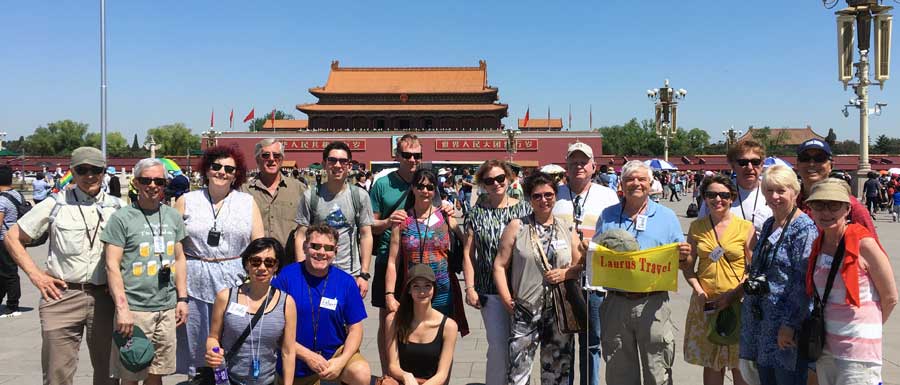
Laurus Travel is the only Canadian China tour operator recommended by Frommer’s. You can find our name in every edition of Frommer’s China, an endorsement money can’t buy. Rated A+ by the BBB and highly regarded by customers across Canada, we have been successfully running tours to China from Canada for 26 years (since 1998). If you are looking for a reliable China tour agency from Canada, you’ve just found it in Laurus Travel. Our solid reputation is your best guarantee for a great China travel experience.
We have many China tours available. One of the most popular China tours we have been running for over two decades is the 19-day China Odyssey. The well-paced itinerary, starting in Beijing and ending in Shanghai, is packed with UNESCO World Heritage Sites. Highlights include the Great Wall, the Terracotta Army Museum, day cruise on the picturesque Li River, and a multi-day cruise on the mighty Yangtze River. Like our other China tours, this premium China tour package features small-group size, outstanding guides hand-picked by company owners, bullet train rides between cities, luxury accommodations and authentic, high-quality Chinese cuisine.
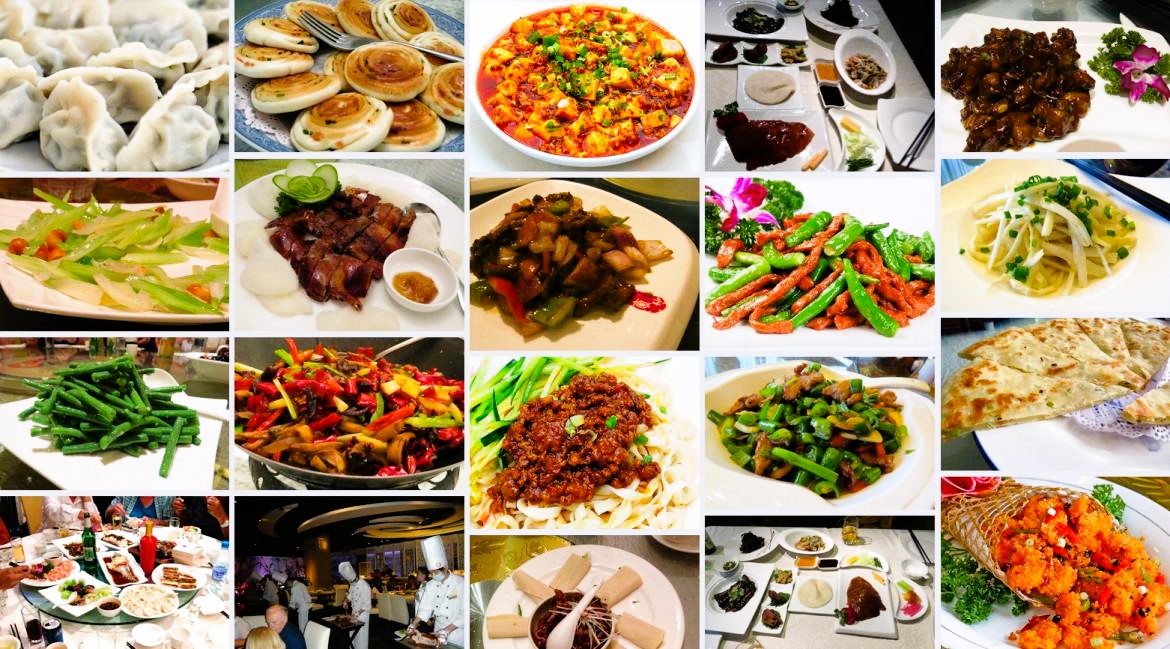
China Odyssey (19 days)
Beijing – Xian – Chengdu – Yangtze Cruise – Yichang – Wuhan – Guilin – Shanghai
Explore ancient sites in Beijing and Xian, admire nature’s beauty in Guilin, sail through the majestic Three Gorges of the Yangtze, savour authentic Chinese cuisines of different regions – this China tour package gives you all that and much more! Trip highlights include the Forbidden City and the Great Wall at Mutianyu in Beijing, Terracotta Army in Xian, a 3-day cruise down the mighty Yangtze, hiking through terraced rice paddies and a day cruise on picturesque Li River in Guilin.
Important Features
- Small group size – average 15, maximum 20
- Expert guides handpicked by company owners
- Inter-city travel by high-speed train except for one city pair (by air)
- No annoying forced shopping of any kind
- Quality meals at non-tourist restaurants
- Unlimited supply of bottled water during group activities
- Deluxe cabin with private balcony on luxury Yangtze cruise
- Free Wi-Fi in all hotels
- Great Wall visit at Mutianyu with cable car rides
- Day hike at Longji terraced rice fields
- and so much more…
Options Available
- Peking Opera show in Beijing
- Tang Dynasty cultural show in Xi’an
- Traditional face mask changing performance in Chengdu
- Half-day immersive team farm visit in Guilin
- Half-day Jewish heritage tour in Shanghai
Meal Code: B = breakfast / L = lunch / D = dinner
Day 1/Thu: Departing for Beijing
The trip starts with your transpacific flight departing from a city of your choice. You’ll lose a day upon crossing the International Date Line.
Day 2/Fri: Arrival in Beijing
Meet the driver on arrival for transfer to the hotel. You’ll have the balance of the day at leisure. The guide will get in touch with you tonight.
Day 3/Sat: Beijing (B/L/D)
Capital of China, Beijing is a world-class cultural and educational centre with a population of 21.7 million (2017), ranking it China’s second largest city behind Shanghai. Beijing is renowned for its opulent palaces, temples, and huge stone walls and gates – treasures that make it the most popular tourist city in China by the number of visitors it receives every year.
We begin today with a visit to the Forbidden City. Officially known as the Palace Museum, the Forbidden City was the place where the emperors of Ming (1368-1644) and Qing (1644-1912) Dynasties lived and carried out their administration. Construction of the Forbidden City took 14 years (1406-1420) to complete. The complex consists of 980 buildings and covers 72 hectares or 180 acres. It exemplifies traditional Chinese palatial architecture and has influenced cultural and architectural developments in East Asia and elsewhere. The Qing Dynasty was overthrown in 1912 but the royal family was allowed to continue to live in the Forbidden City till 1924, when the last emperor, Pu Yi, was driven out of the imperial palace. One year later the Forbidden City was turned into a museum. Declared a World Heritage Site by UNESCO in 1987, this is the largest collection of preserved ancient wooden structures in the world.
Next up is Tian’anmen Square. Located in the heart of Beijing, the square measures 880 metres from north to south and 500 meters from east to west. Said to be the largest public plaza in the world, Tian’anmen Square has the capacity to hold one million people. The imposing Tian’anmen Tower sits at the north end of the square while the Monument to the People’s Heroes dominates the centre. The square is flanked by The Great Hall of the People (west) and the National Museum (east). Chairman Mao’s Mausoleum and Qianmen (Front Gate) are located in the south of the square. One of the top 16 tourist attractions in Beijing, Tian’anmen Square is also the witness of the Chinese people’s great struggles for democracy and personal freedom since 1919.
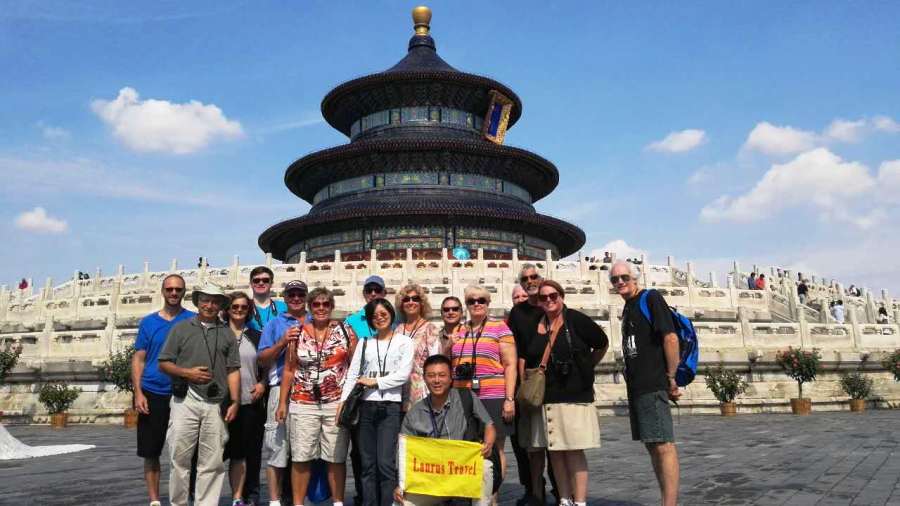
Afternoon sightseeing at the Temple of Heaven, another UNESCO World Heritage Site. Situated in southeastern Beijing the Temple of Heaven is China’s largest extant sacrificial temple where, during the Ming and Qing Dynasties, the emperors conducted the elaborate and most exalted sacrifices addressed to “the Supreme Ruler of the Universe.” Construction of the temple started in 1406, during the reign of the Ming Emperor Yongle, and took 14 years to complete. The temple was expanded under the Qing emperors Qianlong (1736-1796) and Jiaqing (1796-1820). Occupying 2.73 square kilometres (roughly 1,700 by 1,600 metres), the area of the Temple of Heaven is more than twice that of the Forbidden City.
The famous Hongqiao Pearl Market, the largest pearl market in the world, is right across the street from the Temple of Heaven. Recommended by numerous guidebooks for freshwater pearls, Hongqiao teems with domestic and international shoppers. If you are interested, please ask the guide to drop you off there. However, you’ll need to get back to the hotel by taxi, which costs about 50 yuan or US$8.
Today we enjoy a delicious dinner at a popular Peking Roast Duck restaurant. Peking Roast Duck is a famous Beijing dish prized for the thin and crispy skin with authentic versions serving mostly the skin and little meat, sliced in front of the diners. The meat is wrapped in a thin layer of pancake (Chinese tortilla) together with shredded scallion, cucumber, and a sweet and salty sauce made of wheat flour. Condiments may also include pickled garlic and white sugar.
Day 4/Sun: Beijing (B/L)
After an early breakfast we embark on a full-day excursion to the legendary Great Wall at Mutianyu, 75km northeast of the city.
Zigzagging over 6,000 kilometres from east to west along the undulating mountains, the Great Wall was built to hold off tribal invaders from the north. As history shows, the Wall failed the Chinese rulers miserably, especially in the case of Kublai Khan who and his men swept across China from the Mongolian steppe, thus the beginning of the Yuan Dynasty (1279-1368).
Construction of the earliest sections of the Wall started in the 7th century B.C. A major renovation started with the founding of the Ming Dynasty in 1368 and took 200 years to complete. The wall we see today in Beijing is almost exactly the result of this effort.
Day 5/Mon: Beijing – Xian (B/L/D)
We begin our sightseeing today with a visit to a traditional hutong neighbourhood. Hutong refers to an ancient alleyway with siheyuan or ”4-sided courtyard house” on both sides. The name hutong dates back to the Yuan Dynasty (1279 – 1368 A.D.). According to some experts, the word originated from the Mongolian language, in which it is pronounced as hottog and means “well.” In ancient times, people tended to gather and live around wells. So the original meaning of hutong should be “a place where people live around”.
Next on our schedule is the Summer Palace, a well preserved UNESCO World Cultural Heritage Site. The imperial resort was first named Garden of Clear Ripples, which was burnt down by the allied forces of Great Britain and France in 1860 at the end of the Second Opium War (referred to as Arrow War by the British). Reconstruction started 25 years later and was completed in 1895 when the name was changed to Yi He Yuan (Garden of Good Health and Harmony). The design gives prominence to Longevity Hill, and Kunming Lake south of the hill. The sprawling complex covers an area of 290 hectares and the buildings inside consist of over 3,000 bays.
We travel to Xian by the high-speed train (#G87, 14:00/18:23). The 4-hour-23-minute rail journey through fertile farmland dotted with villages provides the visitor an excellent way to enjoy the beautiful countryside. The track we travel on between Beijing and Zhengzhou is part of the new 2,298km high-speed railway linking Beijing and subtropical Guangzhou and is also the longest high-speed rail line in the world. In the past 20 years China has been on a building spree expanding the country’s rail network and upgrading existing railways. Its new high-speed rail service rivals France’s TGV and Japan’s “shinkansen” in terms of safety, speed, comfort and punctuality.
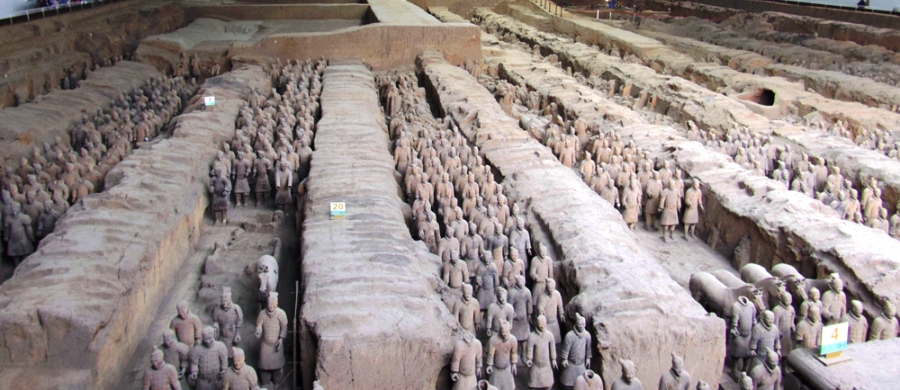
Day 6/Tue: Xian (B/L)
With a history going back over 3,000 years, Xi’an served as China’s capital of several ruling dynasties including the Han (206 BC – 220 AD) and the Tang (618 – 907). It is home of the famous Terracotta Army and the eastern terminus of the ancient Silk Road – a network of trade routes connecting China proper with regions as far as the Mediterranean beginning in the Second Century BC.
Morning visit to the Terracotta Army. Built on the excavation site, the museum is located 30km east of the city. Designed to follow the first emperor of the Qin Dynasty (221-206 BC) into eternity, the Terracotta Army represents one of the greatest archeological discoveries of the 20th Century.
After lunch we return to the city for a stroll on the ancient city wall. Declared a national treasure by the State Council in 1961, the wall first built in 1370 encircles an area of 14 square kilometres. It runs 13.7 kilometres long and measures 12 metres in height with a thickness at the base between 15 to 18 metres.
Day 7/Wed: Xian – Chengdu (B/L/D)
Morning sightseeing begins at Shaanxi Provincial Museum. The modern, well-organized museum was completed in 1992 and traces the history of Xian from prehistory to Qing dynasty (1644-1912). The extensive galleries and exhibitions offer the visitor an excellent introduction to the area that greatly improves understanding of the numerous historical sites in and around the city.
We then visit the grand mosque in the old town centre and the adjacent Muslim bazaar. The mosque was established in the 8th Century but the majority of the complex was constructed in the Ming Dynasty (1368-1644). It was further expanded in the Qing Dynasty (1644-1912). Unlike most mosques in Middle Eastern or Arab countries, this mosque is completely Chinese in architectural style. It has neither domes nor traditional minarets.
This afternoon we ride the bullet train (G1975, 14:34/18:25) to Chengdu, capital of populous Sichuan Province. The ancient city has a population of 14 million with half of that within the urban centre and the remainder in the surrounding districts. A top livable city, Chengdu is one of the most important economic, transportation, and communication hubs in Western China. The fertile Chengdu Plain, on which Chengdu is located, is also known as “Country of Heaven”, a phrase also often translated as “The Land of Abundance”. The discovery of the Jinsha site suggests the area of Chengdu had become the centre of the Bronze Age Sanxingdui culture around the time of the establishment of the state of Shu, prior to its annexation by Qin in 316 BC.
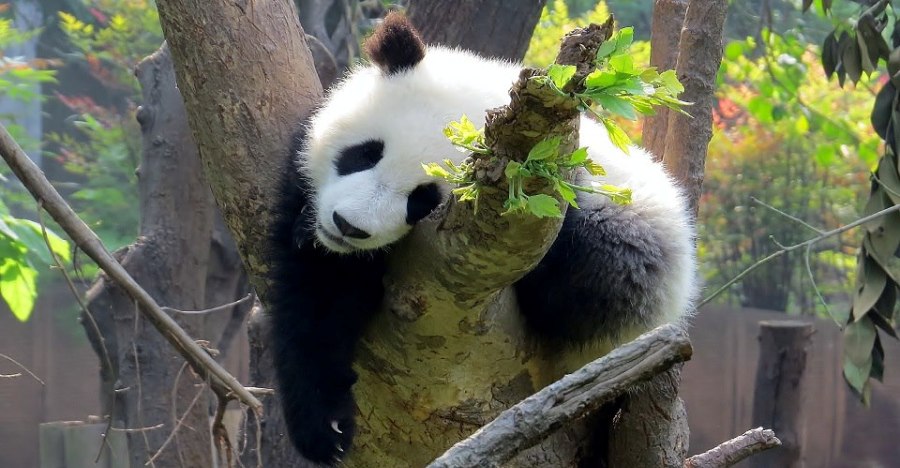
Day 8/Thu: Chengdu (B/L)
Morning sightseeing at Chengdu Research Base of Giant Panda Breeding. The giant panda, unrelated to lesser or red panda, is a bear native to south central China, living in mountainous regions. It is easily recognized by the large, distinctive black patches around its eyes, over the ears, and across its round body. Though it belongs to the order Carnivora, the panda’s diet is over 99% bamboo. The giant panda has an insatiable appetite for bamboo. A typical animal eats half the day – a full 12 out of every 24 hours – and relieves itself dozens of times a day. Giant pandas are solitary creatures. They have a highly developed sense of smell that males use to avoid each other and to find females for mating in the spring. After a five-month pregnancy, females give birth to a cub or two, though they cannot care for both twins. The blind infants born white weigh only 5 ounces (142 grams) at birth and cannot crawl until they reach three months of age. The panda is a conservation reliant endangered species. Recent statistics show 239 pandas living in captivity inside China and another 27 outside the country. Estimates of the wild population vary from 1,000 to as high as 3,000. Some reports also show that the number of pandas in the wild is on the rise.
We spend most of the afternoon at Jinsha Museum built on the excavation site. A significant archaeological discovery in modern China, construction workers chanced upon it in February 2001. The site flourished around 1000 BC and shares similarities in burial objects with the Sanxingdui site located 50 km from Chengdu. Objects made of ivory, jade, bronze, gold and stone were unearthed at the site. Unlike the site at Sanxingdui, Jinsha did not have a city wall. Jinsha culture (1200–650 BC) is believed to be a final phase of Sanxingdui culture and represents a relocation of the political center in the ancient Shu Kingdom.
Day 9/Fri: Chengdu – Chongqing (B/L/D)
Free morning to explore on your own.
Afternoon sightseeing following lunch includes Wang Jiang Lou Park and a typical local tea house. Wangjianglou means “river-overlooking tower” and the park is so named because of the ancient pagoda-shaped wooden tower onsite. The beautiful little park dotted with verdant bamboo groves has long been a favourite spot among locals for leisure.
We ride the bullet train (G2889, 16:10/17:43) to Chongqing where we board the Yangtze cruise ship following after dinner.
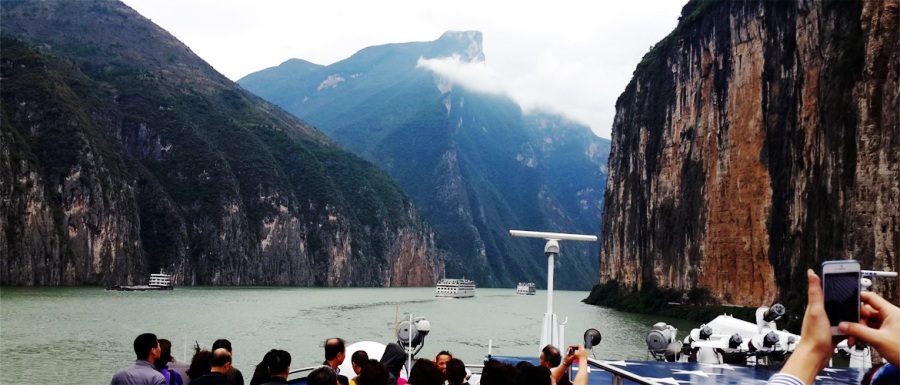
Day 10/Sat: Yangtze Cruise (B/L/D)
At 6,380km the Yangtze is the longest river in China and the third longest in the world after the Nile and the Amazon. The most impressive section of the Yangtze is the Three Gorges stretching 119km.
On today’s shore excursion we visit Precious Stone Fortress (shi bao zhai) built atop a hill overlooking the Yangtze. It was so named because the location was once used as a stronghold by a group of uprising peasants in mid-17th century. About one hundred years later a Buddhist temple was built on the hill. Several more decades passed before a staircase covered by a 9-storey wooden pagoda was added. In 1956, 10 years before the catastrophic Cultural Revolution started, the pagoda was expanded to the current 12 stories.
Day 11/Sun: Yangtze Cruise (B/L/D)
Admire nature’s grandeur while sailing through spectacular Wu Gorge (45km) and Qutang Gorge (8km). Later this morning we hop on a small vessel to explore Goddess Stream. A tributary of the Yangtze, the emerald coloured stream traverses through narrow gorges walled by soaring cliffs.
Day 12/Mon: Yichang – Wuhan (B/L/D)
Morning visit to the Three Gorges Dam site – the largest hydroelectric dam in the world with a reservoir stretching hundreds of kilometres upstream.
We disembark the ship at noon and travel to Wuhan by high-speed train (2 hours). Due to time constraint, we will not be able to have a proper lunch; instead, a lunch box would be provided for you to carry onto the train.
Day 13/Tue: Wuhan – Guilin (B/L/D)
Wuhan is the capital of Hubei Province and a powerful economic engine in central China. A pivotal hub of transportation, the sprawling city straddles the Yangtze. It became known as Wuhan in 1927 when Wuchang, Hangyang and Hankou were amalgamated. The city contains many beautiful lakes and parks including expansive East Lake.
This morning we visit Hubei Provincial Museum. If we are lucky, we may get to watch a live performance featuring a set of bronze chime bells replicated from originals made two and half millennia ago.
After an early lunch we board the high-speed train G435 (13:13/18:27) for Guilin. A small city by Chinese standard, Guilin has long been renowned for its unique scenery. The name Guilin literally means “forest of sweet osmanthus”, owing to the large number of fragrant sweet osmanthus trees in the city.
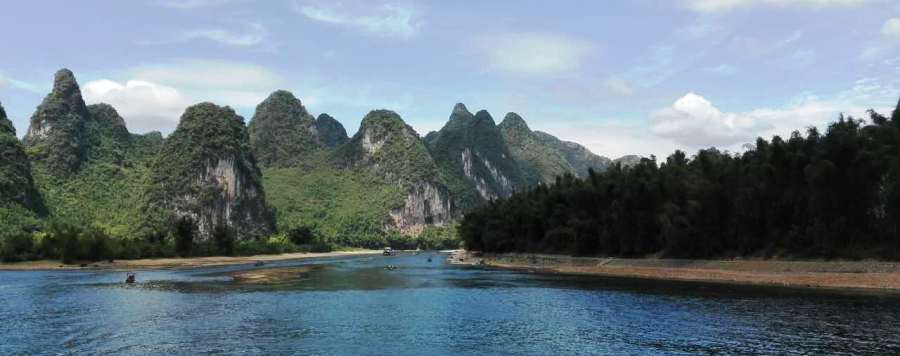
Day 14/Wed: Guilin (B/L)
Enjoy a full-day hiking excursion to the terraced rice fields in Longji. Located 80km (2 hours drive) to the north of Guilin, Longji, meaning dragon back, is famous for its terraced rice fields. Because the villages at Longji are in the jurisdiction of Longsheng County, the tourist attraction is often collectively referred to as Longsheng Terraced Fields. The scenery is arguably at its best in early May during transplanting and in late September to mid-October when the fields turn golden.
Built by local farmers of different ethnic groups from Yuan Dynasty (1271-1368) to Qing Dynasty (1644-1912), the mountainous fields cover a total area of 66 square kilometres, rising between 300 meters and 1,100 metres above sea level.
Optional Tea Farm Visit
If time permits and for a nominal fee, we can arrange a late afternoon visit to Guilin Tea Science and Research Institute, subject to a minimum of 6 participants. Founded in 1956, the state-owned institute has an experimental tea farm covering an area of 42 hectares and boasts 250 species of tea plants. The predecessor of the institute was said to be one of the tea suppliers to the imperial court during the Ming Dynasty. The farm sits on fertile soil ideal for tea growing. During harvesting season, the farm employs 150 workers full time to pick tea leaves. Each year the institute produces around 42 tons of organically grown tea of different flavours.
Day 15/Thu: Guilin (B/L)
We begin today with a five-hour cruise down the Li River. The 83km stretch of the river between Guilin and Yangshuo affords breathtaking scenery as the river snakes through tall karst mountains, gigantic bamboo sprays, and picturesque villages — sights that have inspired countless poets and painters for generations.
We disembark in Yangshuo after lunch on board and drive back to Guilin. We wrap up the day with a quick tour of Fubo Hill (elevation 63 metres) located 2km from the hotel. Walking back to the hotel along Li River is a perfect way to soak in the beauty of the city.
For dinner, you will find all kinds of restaurants around the centrally located hotel. Please consult your local guide for expert advice.
Day 16/Fri: Guilin – Shanghai (B)
Free morning to explore on your own. Transfer to the airport for late afternoon flight to Shanghai.
With a population of 24 million (2015), Shanghai is China’s biggest city, which delights the visitor with its futuristic skyline and historical landmarks. Rapid economic growth in the past 30 years has again turned Shanghai into a leading global city with significant influence in commerce, culture, finance, media, fashion, technology and transport.
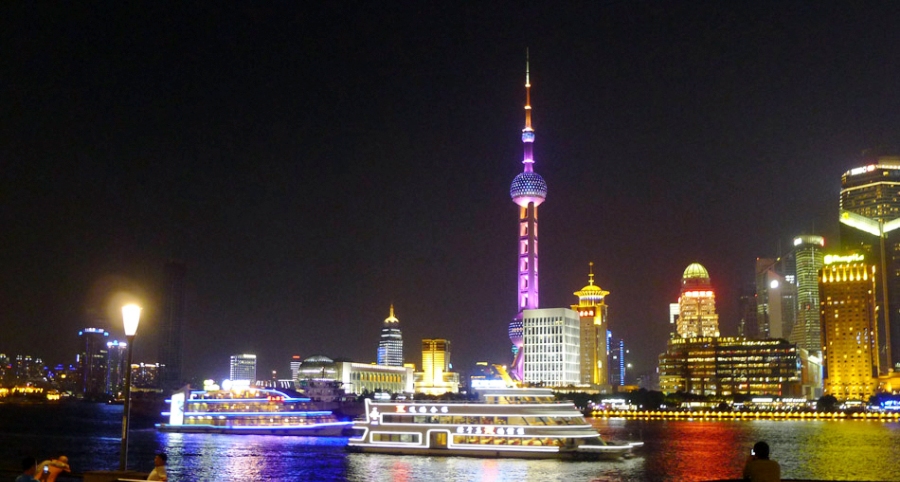
Day 17/Sat: Shanghai (B/L/D)
We begin our day with a visit to Jade Buddha Temple located in an old neighbourhood. Later on we tour the famous waterfront promenade known as the Bund, and the Yu Garden in the old town centre. We wrap up the day with a drive through the glitzy financial district of Lujiazui on the opposite side of the Bund across Huangpu River.
Day 18/Sun: Shanghai (B)
Free day to explore on your own. We recommend Shanghai Museum and the Urban Planning Exhibition Center nearby. Shanghai Museum, a great place to explore on your own (audio guide available for a fee), is frequently cited by visitors as one of the best of its kind in China with a treasure trove collected from around the country.
Optional Suzhou Day Tour
After a leisurely breakfast we ride the high-speed train (30-40 minutes) to Suzhou, an ancient city most famous for its gardens, canals and silk industry. In late 13th Century a Venetian named Marco Polo visited Suzhou and he was very impressed by what he saw. He vividly described the prosperous silk making trade and dubbed Suzhou Venice of the East due to the small waterways crisscrossing the city.
Our full-day schedule takes in historic Tiger Hill, Humble Administrator’s Garden, Suzhou Museum (designed by I.M. Pei), North Pagoda and a short canal cruise. We return to Shanghai by high-speed train (30-40 minutes) in early evening.
The all-inclusive price with hot lunch starts from US$190 per person subject to a minimum of 2 participants.
Day 19/Mon: Shanghai – Home City (B)
Your China tour ends this morning. Transfer to the airport any time for return flight. Guests flying back to North America will regain a day upon re-crossing the International Date Line, thus arriving home the same day as departing from Shanghai.
Your tour ends this morning. Transfer to the airport any time for return flight. Guests flying back to North America will regain a day upon re-crossing the International Date Line, thus arriving home the same day as departing from Shanghai.
| City | Nights | Hotel/Ship | Category |
| Beijing | 3 | New Otani Chang Fu Gong or similar | luxury |
| Xian | 2 | Sheraton Xian North City | luxury |
| Chengdu | 2 | Sofitel Chengdu Taihe | luxury |
| Yangtze Cruise | 3 | Century Cruises (Glory) | luxury |
| Wuhan | 1 | New World Hotel | luxury |
| Guilin | 3 | Sheraton Guilin | luxury |
| Shanghai | 3 | Sheraton Shanghai Hongkou or similar | luxury |
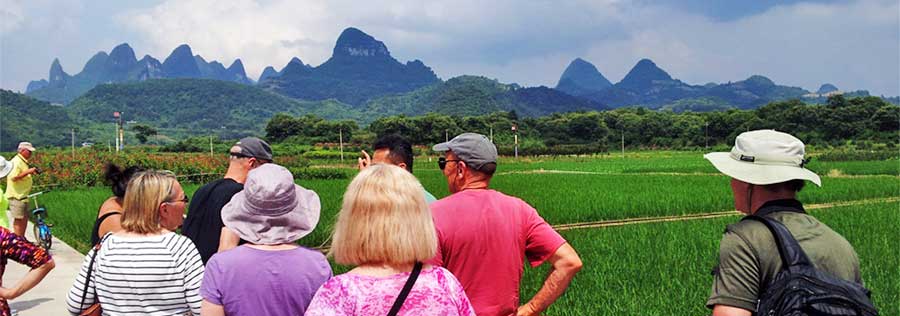
Please click here for departure dates
China Tours from Canada – Testimonials from Canadian Customers
“Hello Heidi, we arrived back from China on Wednesday, November 9th, after fulfilling a long-time dream to visit the land of my father’s birth.
We were fortunate to find your company on the internet and booked the 19 day China Odyssey Tour, plus 2 days in Hong Kong. I want to express a whole-hearted THANK YOU to you and the Laurus Travel team for facilitating what was our first guided trip and one that will remain as our most memorable. There were many things we appreciated about your organization; there were a variety of tour options available for China and other parts of Asia as well as the size of the group. When I contacted you earlier in the year, you were quick to respond and supplied the information requested by us and our two friends who travelled with us, with no pressure for us to book. You followed up when I asked you to and you were very helpful in arranging the flights not only with our preferred airline but were able to secure reduced seat pricing for us. You also obtained our China visas very quickly and saved us a lot of pre-trip leg work. The reminders and travel tips, you provided prior to leaving, were very helpful especially since we were leaving our home for a significant period. Thanks again.
Now, on to the trip itself. On our arrival in Beijing we were happy and relieved to see the Laurus flag being held high by our smiling taxi driver. He didn’t speak a whole lot of English, just enough to let us know where he was taking us. We didn’t know what to expect since this was our first to Asia and as mentioned before our first guided tour. The Sheraton hotel in Dongcheng, Bejing, was extremely well appointed and our stay was exceptional. We ventured out on our own as we arrived one day early and were surprised as to how little English was spoken in Bejing and our Mandarin was at best, laughable. By pointing to the picture of Tiananmen Square on the map, our taxi driver was able to get us there quickly in spite of the rain. Later, we made our way to the recommended South Beauty restaurant close to our hotel and managed to order dinner by pointing to the pictures on the menu. The four of us ate dinner for about 10 people! Every dish was absolutely delicious and spicy. We received a telephone call that evening from Jacob Wei, our extraordinary tour leader, who gave us instructions for the next morning (spoken in perfect English)! What a relief!
China is in one word—Majestic. The splendour of its vast landscape, culture, beautiful people (many), rich history and the mixing of the ancient, well preserved monuments and buildings with the modern sky scrapers, as we saw in every city, particularly Shanghai, certainly exceeded anything we imagined China would be. Photos or print cannot capture or duplicate the reverence one feels when walking on the iconic great wall or experiencing the splendour of the majestic Yangtze River. We woke at 3am to watch the ship go through one of the locks.
The local guides were exceptional and added great dimension to the tour, in particular David in Guilin who eloquently shared so much of the history with us and was able to offer insight on life in modern day China as well. We thoroughly enjoyed Elaine’s female perspective who guided us in Shanghai and yes, she told us where to find the good shops!
A special thank you goes to Jacob Wei, our exceptional and much beloved tour leader who travelled with us, on each leg of the China tour. He was not only very well versed in the history, politics and culture of China but showed true compassion and genuine care for our group. We always felt safe as we knew that he was looking out for us, no matter where we strayed, trying to get the perfect photo. We nicknamed him our “warrior”. It was difficult to say goodbye to him on leaving China; We extended an invitation to host him and his family, should he wish to visit our beautiful country.
Hong Kong was over the top opulent and breathtakingly beautiful. Quite the jaw dropping experience seeing so many tall buildings and the view from the Peak was incredible. We found a wonderful Italian restaurant and although we enjoyed all the delicious chinese dishes in China, we were craving some Italian pasta by this time. We enjoyed our sightseeing day with Alex. who was also very knowledgeable and was amazed at how warm the water was at Repulse Bay beach.
I have nothing but praise for Laurus Travel and the entire team for putting together an amazing tour which exceeded our expectations. Thanks for making my friend’s birthday memorable with a birthday cake at lunch. What a thoughtful touch! Another great aspect of this trip was the friendships we made with the wonderful group of people from Canada & USA who shared this experience with us. We will be more than happy to endorse your organization and hope to travel with you on our next trip to Asia in two years.”
Pamela M
Mississauga, Ontario

